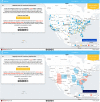GapMap: Enabling Comprehensive Autism Resource Epidemiology
- PMID: 28473303
- PMCID: PMC5438459
- DOI: 10.2196/publichealth.7150
GapMap: Enabling Comprehensive Autism Resource Epidemiology
Abstract
Background: For individuals with autism spectrum disorder (ASD), finding resources can be a lengthy and difficult process. The difficulty in obtaining global, fine-grained autism epidemiological data hinders researchers from quickly and efficiently studying large-scale correlations among ASD, environmental factors, and geographical and cultural factors.
Objective: The objective of this study was to define resource load and resource availability for families affected by autism and subsequently create a platform to enable a more accurate representation of prevalence rates and resource epidemiology.
Methods: We created a mobile application, GapMap, to collect locational, diagnostic, and resource use information from individuals with autism to compute accurate prevalence rates and better understand autism resource epidemiology. GapMap is hosted on AWS S3, running on a React and Redux front-end framework. The backend framework is comprised of an AWS API Gateway and Lambda Function setup, with secure and scalable end points for retrieving prevalence and resource data, and for submitting participant data. Measures of autism resource scarcity, including resource load, resource availability, and resource gaps were defined and preliminarily computed using simulated or scraped data.
Results: The average distance from an individual in the United States to the nearest diagnostic center is approximately 182 km (50 miles), with a standard deviation of 235 km (146 miles). The average distance from an individual with ASD to the nearest diagnostic center, however, is only 32 km (20 miles), suggesting that individuals who live closer to diagnostic services are more likely to be diagnosed.
Conclusions: This study confirmed that individuals closer to diagnostic services are more likely to be diagnosed and proposes GapMap, a means to measure and enable the alleviation of increasingly overburdened diagnostic centers and resource-poor areas where parents are unable to diagnose their children as quickly and easily as needed. GapMap will collect information that will provide more accurate data for computing resource loads and availability, uncovering the impact of resource epidemiology on age and likelihood of diagnosis, and gathering localized autism prevalence rates.
Keywords: autism; autism spectrum disorder; crowdsourcing; epidemiology; prevalence; resources.
©Nikhila Albert, Jena Daniels, Jessey Schwartz, Michael Du, Dennis P Wall. Originally published in JMIR Public Health and Surveillance (http://publichealth.jmir.org), 04.05.2017.
Conflict of interest statement
Conflicts of Interest: None declared.
Figures





References
-
- Center for Disease Control and Prevention (CDC) 2016. [2016-12-13]. Prevalence of autism spectrum disorder among children aged 8 years? autism and developmental disabilities monitoring network, 11 sites, United States, 2010 https://www.cdc.gov/mmwr/preview/mmwrhtml/ss6302a1.htm 6mjYzkcz4.
-
- Elsabbagh M, Divan G, Koh Y, Kim YS, Kauchali S, Marcín C, Montiel-Nava C, Patel V, Paula CS, Wang C, Yasamy MT, Fombonne E. Global prevalence of autism and other pervasive developmental disorders. Autism Res. 2012 Jun;5(3):160–79. doi: 10.1002/aur.239. doi: 10.1002/aur.239. - DOI - DOI - PMC - PubMed
-
- Maenner MJ, Yeargin-Allsopp M, Van Naarden BK, Christensen DL, Schieve LA. Development of a machine learning algorithm for the surveillance of autism spectrum disorder. PLoS One. 2016 Dec;11(12):e0168224. doi: 10.1371/journal.pone.0168224. http://dx.plos.org/10.1371/journal.pone.0168224 - DOI - DOI - PMC - PubMed
-
- Autism and Developmental Disabilities Monitoring Network Surveillance Year 2008 Principal Investigators. Centers for Disease Control and Prevention Prevalence of autism spectrum disorders--Autism and Developmental Disabilities Monitoring Network, 14 sites, United States, 2008. MMWR Surveill Summ. 2012 Mar 30;61(3):1–19. https://www.cdc.gov/mmwr/preview/mmwrhtml/ss6103a1.htm - PubMed
LinkOut - more resources
Full Text Sources
Other Literature Sources

